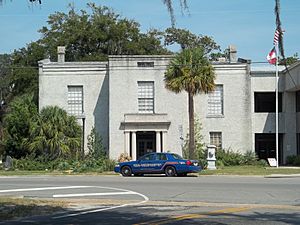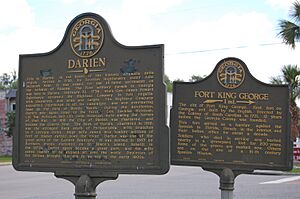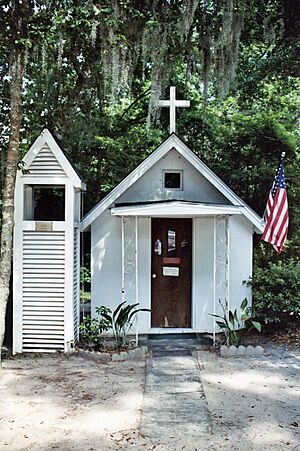McIntosh County, Georgia facts for kids
Quick facts for kids
McIntosh County
|
||
|---|---|---|

McIntosh County Courthouse in Darien
|
||
|
||

Location within the U.S. state of Georgia
|
||
 Georgia's location within the U.S. |
||
| Country | ||
| State | ||
| Founded | 1793 | |
| Named for | Lachlan McIntosh | |
| Seat | Darien | |
| Largest city | Darien | |
| Area | ||
| • Total | 574 sq mi (1,490 km2) | |
| • Land | 424 sq mi (1,100 km2) | |
| • Water | 150 sq mi (400 km2) 26.1%% | |
| Population
(2020)
|
||
| • Total | 10,975 | |
| • Density | 26/sq mi (10/km2) | |
| Time zone | UTC−5 (Eastern) | |
| • Summer (DST) | UTC−4 (EDT) | |
| Congressional district | 1st | |
McIntosh County is a county in the state of Georgia. In 2020, about 10,975 people lived here. The main town and county seat is Darien.
McIntosh County is part of the Brunswick area. This means it's connected to a larger group of towns and cities.
Contents
History of McIntosh County
Early Days and the American Revolution
The area that is now McIntosh County was first settled by the British in 1721. They built Fort King George here. This fort helped protect the British colonies from Spanish Florida to the south. General James Oglethorpe led this effort.
In 1736, Scottish Highlanders founded a town called New Inverness. It was later renamed Darien. These Scottish settlers were encouraged by General Oglethorpe to move to Georgia.
Later, in 1760, the British built Fort Barrington. This fort was an important center for travel and communication. McIntosh County officially became a county in 1793. It was created from part of Liberty County.
The county was named after the famous McIntosh family. Lachlan McIntosh was a general in the Continental Army during the American Revolution. His family had been in Darien since 1736.
The Civil War Period
McIntosh County faced many challenges during the Civil War. The war badly damaged its farms and lumber industry. The busy port town of Darien, Georgia was also destroyed. This happened in June 1863 when Colonel James Montgomery ordered it to be burned.
Capture of 26 Older Men
After Darien was burned in 1863, the area was mostly unprotected. A group of older men, who were too old for military service, tried to defend against looting. These men met at Ebenezer Church on August 3, 1864.
A spy told the U.S. military about their meeting. U.S. troops surrounded the church and attacked. All 26 men were captured. They were marched about 10 miles to Darien. From there, they were put on ships and sent to prisons in the north.
Rebuilding After the War
After the Civil War, McIntosh County became a place where Black citizens gained political power. This lasted until 1907. Tunis G. Campbell Sr. was a very important African American politician in Georgia.
In 1865, Campbell Sr. helped manage land claims for formerly enslaved people. He worked with the Freedmen's Bureau. When some land was returned to plantation owners, Campbell Sr. bought 1,250 acres. He created a group of Black landowners there.
By 1867, McIntosh County had more Black voters than white voters. Campbell Sr. was elected as a state senator. His son, Tunis G. Campbell Jr., became a state representative for McIntosh County. They both faced challenges but returned to office later.
Campbell Sr. also served as the Vice President of the Georgia Republican Party. He helped protect Black citizens from unfair treatment. This strong political presence lasted for many decades. McIntosh County had three Black representatives between 1875 and 1907.
The Civil Rights Era
Even with many Black residents, white leaders mostly controlled McIntosh County politics until the 1970s. In 1975, a legal group filed a lawsuit. They said that women and Black people were unfairly kept off juries. These juries chose members for the county's Board of Education.
In 1976, an agreement was reached. It made sure that jury members would be chosen randomly.
In 1977, the NAACP filed more lawsuits. They argued that the county and city election districts were unfair. The county agreed to change its district lines. This created a district where Black voters were the majority.
The book Praying for Sheetrock tells the story of the civil rights movement in McIntosh County. It covers events like the death of Sheriff Thomas H. Poppell. It also describes the 1978 election of Thurnell Alston, a Black rights activist, as a county commissioner.
Geography
McIntosh County covers about 574 square miles. About 424 square miles are land, and 150 square miles are water. This means about 26% of the county is water.
Most of the county is in the Ogeechee River area. The Altamaha River forms the entire southwestern border of the county.
Neighboring Counties
- Liberty County (north)
- Glynn County (south)
- Wayne County (west)
- Long County (northwest)
Protected Natural Areas
- Blackbeard Island National Wildlife Refuge
- Harris Neck National Wildlife Refuge
- Wolf Island National Wildlife Refuge
Islands
- Sapelo Island
- Blackbeard Island
- Four Mile Island
- Creighton Island
- Wolf Island
- Black Island
- Hird Island
- Little Sapelo Island
- Wahoo Island
Communities
City
- Darien (the county seat)
Unincorporated Communities
Population Information
McIntosh County has seen its population change over the years. In 2020, the population was 10,975 people. This was a decrease from 14,333 people in 2010.
| Race | Number of People | Percentage |
|---|---|---|
| White (not Hispanic) | 7,060 | 64.33% |
| Black or African American (not Hispanic) | 3,176 | 28.94% |
| Native American | 32 | 0.29% |
| Asian | 43 | 0.39% |
| Other/Mixed | 433 | 3.95% |
| Hispanic or Latino | 231 | 2.1% |
In 2020, there were 10,975 people living in the county. There were 6,042 households and 4,065 families.
Transportation
Major Roads
 I-95 (Interstate 95)
I-95 (Interstate 95) US 17
US 17 SR 99
SR 99 SR 251
SR 251
Traffic Lights
McIntosh County is special because it has no regular traffic lights that change colors. There are two flashing lights. One is in Eulonia at the intersection of US-17 and GA-99. The other is in downtown Darien at US-17 and First Street. There have been talks about adding more traffic lights in Darien due to more cars, but no plans are final.
Railroads
McIntosh County is one of the few counties in Georgia without an active railroad. A railroad used to run through the county, but it was removed in the late 1980s. You can still see signs of where the tracks used to be in many places.
Notable People
- Thomas Spalding (1774–1851) – A U.S. Representative.
- John McIntosh Kell (1823–1900) – An officer on the CSS Alabama during the Civil War.
- Charles S. Thomas (1849–1934) – A United States Senator for Colorado.
- Arthur Conley (1946–2003) – A famous soul singer.
- Allen Bailey (born 1989) – A defensive end who played for the Kansas City Chiefs.
See also
 In Spanish: Condado de McIntosh (Georgia) para niños
In Spanish: Condado de McIntosh (Georgia) para niños





